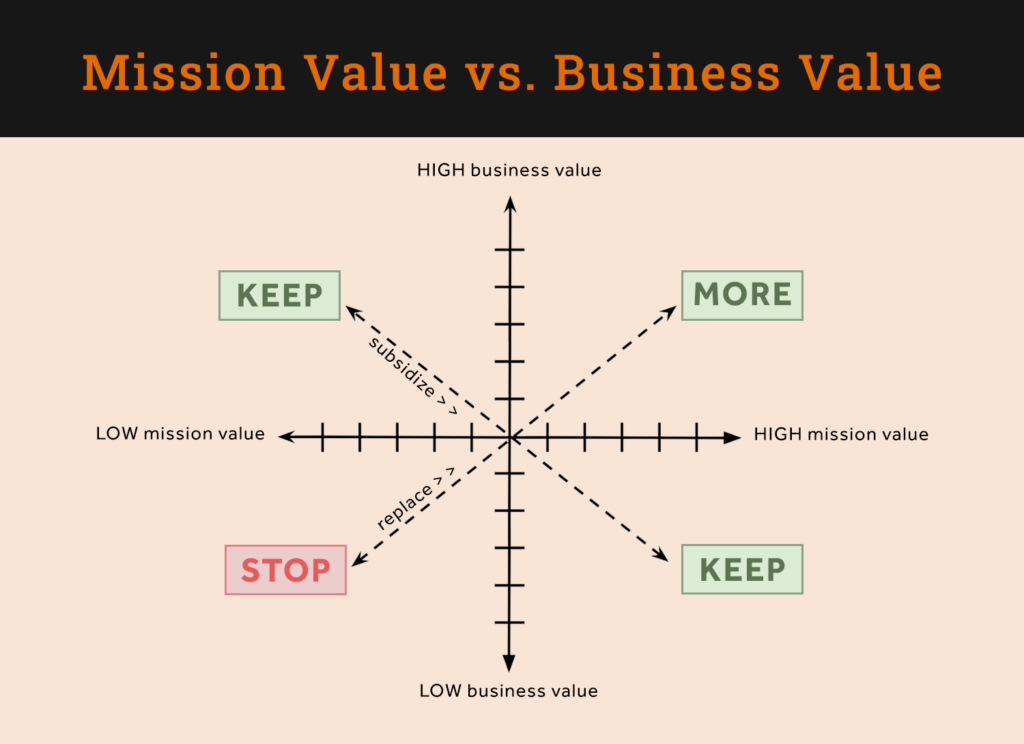It’s surprisingly difficult for organizations of any kind to stop doing things. And the more complex the thing (or the organization), the harder it can be to kill. Some of the reasons why may sound familiar to anyone working in a newsroom:
- Leaders and managers aren’t aware of all the projects happening across the organization, which means they don’t have an accurate perception of people’s workloads.
- Leaders and managers aren’t aware of the “multiplier effect” — that one initiative in one department could require resources from another, which could stretch them too thin.
- People leave or are let go, but their work is simply transferred to another employee.
- Inertia gets the best of us. Usually we refer to inertia when unable to get something started, but it can also apply to stopping things. Sometimes it’s easier to just keep doing things rather than figure out a way (or a good reason why) to stop them.
The first step to stop doing work that’s not worthwhile is to ask your staff — regularly and often — “What are you doing that you don’t think is a good use of your time, and why?”
The Milwaukee Journal Sentinel kept a running list titled “Stuff we need to give up!” Employees were encouraged to add anything to the list that did not directly support their top priority of increasing digital subscriptions. They also added the tasks and responsibilities of people who had left and were not replaced. “If we aren’t willing or able to go out and recruit someone to take over where someone left off, then put it on the list,” editors wrote.
Something going on the list didn’t mean it had to be immediately abandoned — but it did mean its ROI would be scrutinized. In the end, they ended up saying “good riddance” to tedious, fruitless tasks like manually tweeting to all Twitter accounts, posting to Facebook pages that barely had any followers, and posting certain “print” items online. They also killed a Facebook Live show, “JS on Politics,” that few people were watching.
Ask your staff — regularly and often — “What are you doing that you don’t think is a good use of your time, and why?”
You could incorporate the question — “What are you doing that you don’t think is a good use of your time, and why?” — into performance reviews, ask it at every team meeting or company-wide meeting, or even create a “Stuff we need to stop doing” Slack channel. Or follow the Journal Sentinel’s example and keep a running list in a central location.
Of course, it’s not really the question but the discussions that follow that are important. It’s an exercise in thinking critically about how everyone’s work, each of their tasks, contributes to the business goals.
Yes, it can be an awkward (and loaded) question. Employees may hesitate to speak up about work they want to shed for fear of being perceived as lazy, or that it means their job is disposable. People may also hesitate to give up work that is familiar and comfortable for them — especially if they think they will be asked to take on something else that is new and challenging.
So if you’re reading this and you’re a manager, know that it’s up to you to anticipate these concerns and proactively address them. When broaching the conversation about stopping certain types of work, managers should stress the following:
- Shedding low-impact work is just as much an accomplishment — and cause for celebration — as, say, launching a new product or reporting series, or winning an award.
- Giving up certain work doesn’t mean it was poorly done or never important, but that your audience’s needs are evolving.
- Doing this helps everyone become more aligned on mission-critical work.
- It also helps reduce workloads and prevent burnout (hence, a cause for celebration).
- If employees need help phasing out projects or tasks, they will get it. (Managers, don’t underdeliver on this promise!)
Once you start having these conversations in your newsroom and identifying some things you may want to stop doing, here’s a simple framework we’ve created for deciding what truly is not worthwhile.
In the top-right quadrant are items that both drive revenue and are aligned with your news organization’s mission — enterprise reporting that is shown to engage readers and drive subscriptions, for example. Things that fall into this category of work are likely worth continuing.
In the bottom-left quadrant are items that neither drive revenue nor are central to carrying out your mission. Consider this category the “low-hanging fruit” in your effort to cut out low-value work.
Things that fall into the top-left quadrant — they drive revenue but aren’t “mission-critical” — may be worth continuing and can help “subsidize” the work in the bottom-right quadrant, which doesn’t necessarily drive revenue but nonetheless is central to your mission.
Another great tactic to home in on low-value work is to ask staffers to identify the tasks they spend the most time on. Out of these, which are neither mission- nor business-critical?
Now that we’ve covered this general approach, let’s move on to the specifics of trimming low-performing content.
Share with your network
How newsrooms can do less work – but have more impact
You also might be interested in:
It’s been a busy year for us: we held three API Local News Summits, built out a comprehensive guide to partnering with influencers, encouraged experiments with grants and cohorts, and supported news organizations with our products.
Today, we’re undergoing a bold transformation — reimagining ourselves as a platform that fosters generational solidarity and serves bicultural audiences from Gen Z to Boomers.
As director of inclusion and audience growth, Harris-Taylor will continue API’s efforts to drive organizational and cultural transformation while sharpening its commitment to diversity, equity, inclusion and belonging. She’ll also work to deepen API’s partnerships with community organizations and non-news experts.





